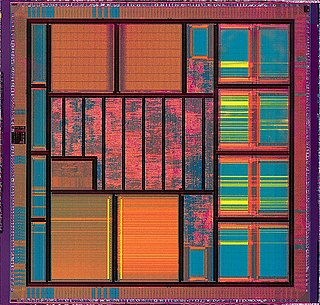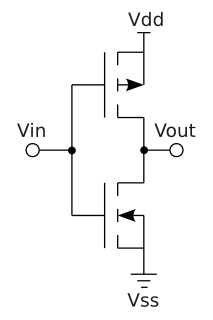
An integrated circuit or monolithic integrated circuit is a set of electronic circuits on one small flat piece of semiconductor material, usually silicon. Large numbers of tiny MOSFETs integrate into a small chip. This results in circuits that are orders of magnitude smaller, faster, and less expensive than those constructed of discrete electronic components. The IC's mass production capability, reliability, and building-block approach to integrated circuit design has ensured the rapid adoption of standardized ICs in place of designs using discrete transistors. ICs are now used in virtually all electronic equipment and have revolutionized the world of electronics. Computers, mobile phones, and other digital home appliances are now inextricable parts of the structure of modern societies, made possible by the small size and low cost of ICs such as modern computer processors and microcontrollers.

Very large-scale integration (VLSI) is the process of creating an integrated circuit (IC) by combining millions of MOS transistors onto a single chip. VLSI began in the 1970s when MOS integrated circuit chips were widely adopted, enabling complex semiconductor and telecommunication technologies to be developed. The microprocessor and memory chips are VLSI devices. Before the introduction of VLSI technology, most ICs had a limited set of functions they could perform. An electronic circuit might consist of a CPU, ROM, RAM and other glue logic. VLSI enables IC designers to add all of these into one chip.

The metal–oxide–semiconductor field-effect transistor, also known as the metal–oxide–silicon transistor, is a type of insulated-gate field-effect transistor that is fabricated by the controlled oxidation of a semiconductor, typically silicon. The voltage of the covered gate determines the electrical conductivity of the device; this ability to change conductivity with the amount of applied voltage can be used for amplifying or switching electronic signals.

Complementary metal–oxide–semiconductor, also known as complementary-symmetry metal–oxide–semiconductor (COS-MOS), is a type of metal–oxide–semiconductor field-effect transistor (MOSFET) fabrication process that uses complementary and symmetrical pairs of p-type and n-type MOSFETs for logic functions. CMOS technology is used for constructing integrated circuit (IC) chips, including microprocessors, microcontrollers, memory chips, and other digital logic circuits. CMOS technology is also used for analog circuits such as image sensors, data converters, RF circuits, and highly integrated transceivers for many types of communication.
Neuromorphic engineering, also known as neuromorphic computing, is the use of very-large-scale integration (VLSI) systems containing electronic analog circuits to mimic neuro-biological architectures present in the nervous system. A neuromorphic computer/chip is any device that uses physical artificial neurons to do computations. In recent times, the term neuromorphic has been used to describe analog, digital, mixed-mode analog/digital VLSI, and software systems that implement models of neural systems. The implementation of neuromorphic computing on the hardware level can be realized by oxide-based memristors, spintronic memories, threshold switches, and transistors.
Bipolar CMOS (BiCMOS) is a semiconductor technology that integrates two formerly separate semiconductor technologies, those of the bipolar junction transistor and the CMOS gate, in a single integrated circuit device.
In semiconductor manufacturing, silicon on insulator (SOI) technology is fabrication of silicon semiconductor devices in a layered silicon–insulator–silicon substrate, to reduce parasitic capacitance within the device, thereby improving performance. SOI-based devices differ from conventional silicon-built devices in that the silicon junction is above an electrical insulator, typically silicon dioxide or sapphire. The choice of insulator depends largely on intended application, with sapphire being used for high-performance radio frequency (RF) and radiation-sensitive applications, and silicon dioxide for diminished short-channel effects in other microelectronics devices. The insulating layer and topmost silicon layer also vary widely with application.

A mixed-signal integrated circuit is any integrated circuit that has both analog circuits and digital circuits on a single semiconductor die.

Interuniversity Microelectronics Centre (imec) is an international research & development organization, active in the fields of nanoelectronics and digital technologies. Luc Van den hove has served as President and CEO since 2009.
The 32 nm node is the step following the 45 nm process in CMOS (MOSFET) semiconductor device fabrication. "32-nanometre" refers to the average half-pitch of a memory cell at this technology level. Toshiba produced commercial 32 GiB NAND flash memory chips with the 32 nm process in 2009. Intel and AMD produced commercial microchips using the 32-nanometre process in the early 2010s. IBM and the Common Platform also developed a 32 nm high-κ metal gate process. Intel began selling its first 32 nm processors using the Westmere architecture on 7 January 2010.

Technology computer-aided design is a branch of electronic design automation that models semiconductor fabrication and semiconductor device operation. The modeling of the fabrication is termed Process TCAD, while the modeling of the device operation is termed Device TCAD. Included are the modelling of process steps, and modelling of the behavior of the electrical devices based on fundamental physics, such as the doping profiles of the devices. TCAD may also include the creation of compact models, which try to capture the electrical behavior of such devices but do not generally derive them from the underlying physics.
The 180 nm process refers to the level of MOSFET (CMOS) semiconductor process technology that was commercialized around the 1998–2000 timeframe by leading semiconductor companies, starting with TSMC and Fujitsu, then followed by Sony, Toshiba, Intel, AMD, Texas Instruments and IBM.
Nanoelectronics refers to the use of nanotechnology in electronic components. The term covers a diverse set of devices and materials, with the common characteristic that they are so small that inter-atomic interactions and quantum mechanical properties need to be studied extensively. Some of these candidates include: hybrid molecular/semiconductor electronics, one-dimensional nanotubes/nanowires or advanced molecular electronics.
Chih-Tang "Tom" Sah is a Chinese-American electronics engineer. He is best known for inventing CMOS logic with Frank Wanlass at Fairchild Semiconductor in 1963. CMOS is now used in nearly all modern very large-scale integration (VLSI) semiconductor devices.
Adrian (Mihai) Ionescu is a full Professor at the Swiss Federal Institute of Technology in Lausanne (EPFL).
The IEEE International Electron Devices Meeting (IEDM) is an annual micro- and nanoelectronics conference held each December that serves as a forum for reporting technological breakthroughs in the areas of semiconductor and related device technologies, design, manufacturing, physics, modeling and circuit-device interaction.

Technology readiness levels (TRLs) are a method for estimating the maturity of technologies during the acquisition phase of a program, developed at NASA during the 1970s. The use of TRLs enables consistent, uniform discussions of technical maturity across different types of technology. A technology's TRL is determined during a Technology Readiness Assessment (TRA) that examines program concepts, technology requirements, and demonstrated technology capabilities. TRLs are based on a scale from 1 to 9 with 9 being the most mature technology. The US Department of Defense has used the scale for procurement since the early 2000s. By 2008 the scale was also in use at the European Space Agency (ESA).
RF CMOS is a metal–oxide–semiconductor (MOS) integrated circuit (IC) technology that integrates radio-frequency (RF), analog and digital electronics on a mixed-signal CMOS RF circuit chip. It is widely used in modern wireless telecommunications, such as cellular networks, Bluetooth, Wi-Fi, GPS receivers, broadcasting, vehicular communication systems, and the radio transceivers in all modern mobile phones and wireless networking devices. RF CMOS technology was pioneered by Pakistani engineer Asad Ali Abidi at UCLA during the late 1980s to early 1990s, and helped bring about the wireless revolution with the introduction of digital signal processing in wireless communications. The development and design of RF CMOS devices was enabled by van der Ziel's FET RF noise model, which was published in the early 1960s and remained largely forgotten until the 1990s.
Luc Van den hove is President and Chief Executive Officer (CEO) of IMEC, Europe's largest independent research center in the field of nanoelectronics and digital technologies.
Electrochemical Random-Access Memory (ECRAM) is a type of non-volatile memory (NVM) with multiple levels per cell (MLC) designed for deep learning analog acceleration. An ECRAM cell is a three-terminal device composed of a conductive channel, an insulating electrolyte, an ionic reservoir, and metal contacts. The resistance of the channel is modulated by ionic exchange at the interface between the channel and the electrolyte upon application of an electric field. The charge-transfer process allows both for state retention in the absence of applied power, and for programming of multiple distinct levels, both differentiating ECRAM operation from the one of a field-effect transistor (FET). The write operation is deterministic and can result in symmetrical potentiation and depression, making ECRAM arrays attractive for acting as artificial synaptic weights in physical implementations of artificial neural networks (ANN). The technology challenges include open circuit potential (OCP) and semiconductor foundry compatibility associated with energy materials. Universities, government laboratories, and corporate research teams have contributed to the development of ECRAM for analog computing. Notably, Sandia National Laboratories designed a lithium-based cell inspired by solid-state battery materials, Stanford University built an organic proton-based cell, and International Business Machines (IBM) demonstrated in-memory selector-free parallel programming for a logistic regression task in an array of metal-oxide ECRAM designed for insertion in the back end of line (BEOL).







